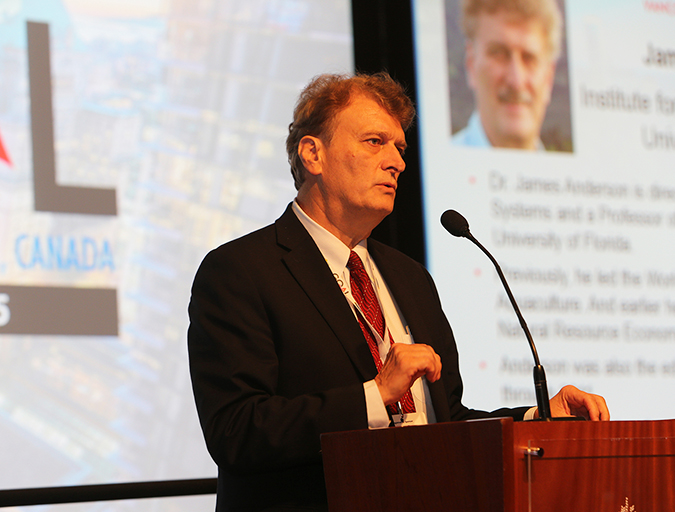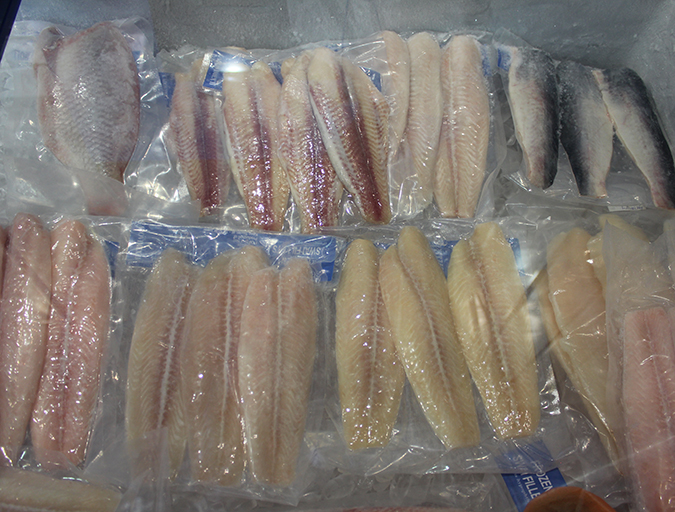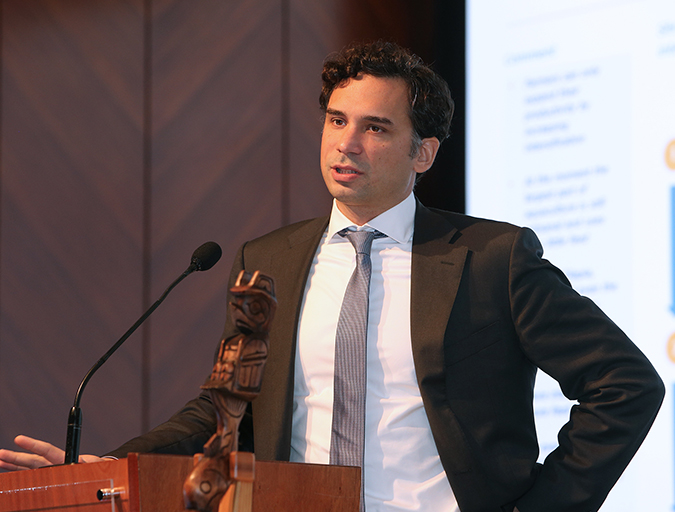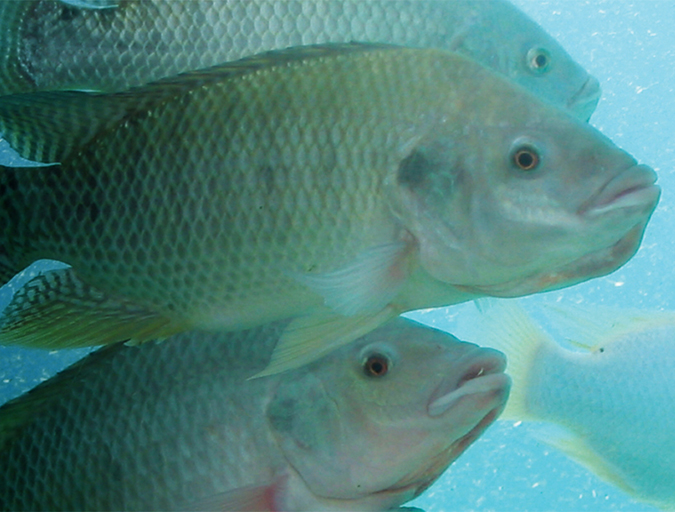Triennial event in Las Vegas attracts nearly 2,700 participants from around the world

Eighty-five different topics were addressed at the recent Aquaculture 2016 conference and trade show, a triennial event organized by the World Aquaculture Society. The subject matter ranged from diseases and animal welfare to engineering, production systems and equipment.
Keynote speaker Dr. James Anderson, director of the Institute for Sustainable Food Systems and professor of food and resource economics at the University of Florida, spoke on “The Future of Aquaculture and its Role in the Global Food System.”
With the need to increase global aquaculture production by 62 percent in the next 15 years — drawing on findings from the recent “Fish to 2030” report by the World Bank — Anderson stated that areas where production growth is the greatest must put a greater focus on quality and consistency.
Anderson also emphasized the need to reframe aquaculture’s message to consumers and investors, keying in on the positives regarding aquaculture’s environmental footprint in comparison to other animal proteins. Aquaculture more efficiently uses resources, wastes less and has a greater cost/value proposition, he added. The industry should also promote health benefits, he argued, but should better manage diseases, which he deemed the biggest risk to industry growth.
Anderson concluded that aquaculture will continue to grow because fisheries cannot meet market demands of a growing global population. By the aforementioned year 2030, China will be consuming nearly 40 percent of all seafood, Anderson said, with two-thirds of the global seafood supply originating from farms. Production of tilapia and shrimp will nearly double, but the largest tonnage gains will be in mollusks. Look to India, Latin America and Southeast Asia for growth.
While Anderson said that algae utilization should be a greater area of focus for aquafeed producers, Dr. John Benemann of MicroBio Engineering in San Luis Obispo, Calif., said algae is high in protein, oils, vitamins, carotenoids and antioxidants, and can boost fish’s immune systems.
By the aforementioned year 2030, China will be consuming nearly 40 percent of all seafood, Anderson said, with two-thirds of the global seafood supply originating from farms.
Currently, global commercial microalgae production is relatively small, with slightly less than 20,000 tons of biomass produced annually by autotrophic cultures (sunlight and carbon dioxide) and approximately an equal amount by fermentation. Current production is mostly focused on human nutritional markets, although spirulina is used in some specialty aquafeeds. Live microalgae feeds for aquaculture are produced for shrimp, bivalve and fish hatcheries and nurseries.
Dr. Benemann concluded that the aquaculture industry will benefit from these products through better nutrition and reduced costs, while using environmentally sustainable resources and production technologies.
New aquafeeds and feeding technologies are promising, said Dr. Craig L. Browdy of Zeigler Bros, based in Gardners, Pa. Achieving the level of industry growth needed to feed a growing human population, while continuing to maintain profitability and improve environmental sustainability, demands new technological innovations in aquaculture feeds and feeding.
Changes in immune balance and gut health can provide early indications of effects too subtle to be discerned through traditional growth studies. When coupled with continuing progress in breeding, these advancements will enable production of more seafood, more profitably using less limited resources.
The emergence and expansion of tuna fattening and farming activities during the last four decades has led to a shift from traditional fisheries towards aquaculture, said Dr. Daniel Benetti of the University of Miami. This change is entirely reshaping the tuna fishery industry and the management of their stocks worldwide, Benetti added.
Tuna fattening and farming operations still rely primarily on wild caught juveniles that are fattened using small pelagic fish, merging these activities and blurring the line between fisheries and aquaculture. Progress in fattening operations has been limited to improved management and decreased mortalities during the capture, towing, transferring, and feeding stages of the tuna in cages. However, tuna aquaculture is now rapidly changing due to remarkable progress in closed cycle tuna aquaculture production through advancements in broodstock maturation, spawning, larval rearing, and juvenile production technologies.
Benetti said that closing the life cycle and the development of ecologically and economically efficient feeds that meet the specific nutritional requirements of tunas are needed to ensure future production and the conservation of tuna species.
Other important notes from the conference include:
- Dane Klinger of Princeton University stated that most while aquaculture is currently land-based, future production will expand into the ocean due to increasing competition for inputs to on-land and coastal aquaculture and growing demand for seafood. Production potential can be compared across species and regions and with climate change, based on outputs of a recent high-resolution global climate model.
- Regarding where aquaculture activities will be conducted, aquaculture zoning, site selection and area management under the ecosystem approach to aquaculture is crucial, said Dr. José Aguilar-Manjarrez of the Food and Agriculture Organization of the United Nations (FAO). His discussion called for pragmatic, systematic and flexible planning and management, which may need some considerable inputs of participation, persistence, adequate funding and good governance to create an environment conducive to sustainable aquaculture development.
- Randall Brummett of the World Bank said that improving the efficiency of the food production system has been the focus of much discussion in conservation and development circles. In an analysis of global food security in the context of the Anthropocene Epoch, the UK Office of Science has proposed “Sustainable Intensification,” using less land and water to produce more food, another way of describing efficiency, as the best way forward in reconciling the needs of people and biodiversity. We should not have to face choices between food or nature and food or jobs, Brummett said, concluding that it is the responsibility of food security and conservation policy makers and development planners to develop efficient administrative and management mechanisms to transform ecologically and technically efficient technologies into environmentally friendly economic growth and food security.
- Andrea C. Alfaro of the Auckland University of Technology (Auckland, New Zealand) discussed metabolomics as an innovative and powerful tool for aquaculture. Because metabolites are most sensitive to environmental changes, they provide information about what is actually happening at the metabolic and physiological level. Metabolomics, he said, can signal the potential to generate predictive models of larval performance, and future research will eventually lead to easy-to-use tool kits to evaluate the physiological state of larvae throughout the rearing process.
- Brett Koonse of the U.S. Food and Drug Administration discussed aquaculture food safety and disease management as a new paradigm. Koonse said aquaculture products are also the primary source of protein for one fifth of the world’s population, mainly in the developing world. This is extremely important for food security because with expected world population growth, the demand for food will increase by 110 percent and result in a huge demand and an opportunity for aquaculture products. However, there are food safety concerns with farmed products, including the presence of unsafe residues, pathogens, and the potential to contribute to antimicrobial resistance. When food safety problems are found there are a range of negative impacts, including significant costs to producers, processors, buyers, importers, and the regulatory agencies, market disruptions, an increase in the negative perception of aquaculture, lost markets and others. Koonse described a new way of approaching aquaculture food safety, minimizing the risk of trade interruptions due to food safety concerns, and an approach to obtaining more customer confidence in aquaculture.
- George Chamberlain, president of the Global Aquaculture Alliance (GAA), received the WAS Honorary Life Award for long-standing and significant contribution to global aquaculture development.
- Attended by around 2,700 participants from many countries, Aquaculture 2016 also has a trade show component that showcased more than 200 exhibitors representing major industry suppliers and vendors. The triennial event is a partnership of WAS and many other industry associations, including the National Shellfisheries Association, the Fish Culture Section of the American Fisheries Society, and the National Aquaculture Association. It also involved several contributing sponsors, including the U.S. Aquaculture Suppliers Association, American Veterinary Medical Association, the Tilapia Alliance, the Aquaculture Engineering Society, the Aquaculture Association of Canada, the Aquaculture Feed Industry Association, the International Association of Aquaculture Economics and Management, the World Aquatic Veterinary Medical Association, and the Global Aquaculture Alliance, among others.
Now that you've reached the end of the article ...
… please consider supporting GSA’s mission to advance responsible seafood practices through education, advocacy and third-party assurances. The Advocate aims to document the evolution of responsible seafood practices and share the expansive knowledge of our vast network of contributors.
By becoming a Global Seafood Alliance member, you’re ensuring that all of the pre-competitive work we do through member benefits, resources and events can continue. Individual membership costs just $50 a year.
Not a GSA member? Join us.
Author
-

Darryl Jory, Ph.D.
Editor Emeritus
Global Aquaculture Alliance[103,114,111,46,101,99,110,97,105,108,108,97,97,103,64,121,114,111,106,46,108,121,114,114,97,100]
Related Posts

Intelligence
GOAL video: James Anderson on shrimp trends
James Anderson delivered a data-rich survey on global shrimp and finfish production volumes for the Global Aquaculture Alliance at its GOAL conference in October. See the full video of his presentation.

Intelligence
Global finfish production review: Gradual growth
Recent surveys indicate that global finfish production has doubled over the last decade, but most of this growth happened in the first half of this period. Production is still growing but at slower pace than in recent years, and annual growth rates must increase to at least 7.2 percent to maintain the double-in-a-decade objective.

Aquafeeds
GOAL video: Gorjan Nikolik on fishmeal
Gorjan Nikolik, senior industry analyst for Rabobank, presented on fishmeal’s transformation from commodity to a “high-priced strategic protein” at the Global Aquaculture Alliance’s annual GOAL conference in Vancouver. See the full video of his presentation.

Health & Welfare
Aquaculture disease experts to download at GOAL 2016
At this year’s GOAL conference in Guangzhou, China, leading animal welfare and aquatic animal disease experts will share knowledge about how producers can gird their operations. EMS, EHP, streptococcosis and sea lice will be addressed, as will the latest in area management.


